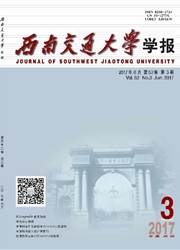

 中文摘要:
中文摘要:
为探讨雷暴冲击风作用下山地不同坡度角对于高层建筑表面风荷载的影响,为高层建筑结构设计提供参考依据,采用冲击射流装置进行风洞试验,对同一高层建筑在平地及不同坡度角的山地等多种地形下表面风压的分布特性进行试验研究,并借助计算流体力学软件FLUENT对试验工况进行了模拟和补充,分析了雷暴冲击风作用下平地地形、坡地地形下高层建筑表面风压分布特性以及起坡角度对建筑风荷载特性的影响规律.研究结果表明:平地时,不同径向位置处高层建筑各层阻力系数分布沿高度具有相同的变化规律,层阻力系数随着径向距离的增大而减小,径向距离由射流喷口直径的1.0倍变化到3.0倍的过程中,层平均阻力系数最大值由1.3减小到0.3;坡地时,高层建筑迎风面的风压值与山地坡度角的增加呈负相关,极值风压所在高度同样随着起坡角度的增加而减小;从平地到90°坡地,极值风压系数减小幅度达到0.7以上,极值风压出现的高度由建筑物高度的1/4处降低到建筑物底部附近.
 英文摘要:
英文摘要:
To analyze the effects of thunderstorm downburst wind on the surface wind load of high-rise buildings and provide a reference for the design of high-rise buildings, the wind pressure distribution on the surface of high-rise buildings on flat and sloped terrains was investigated using an impinging jet device in wind tunnel tests. The computational fluid dynamics software FLUENT was used to simulate and supplement the test cases,analyze the characteristics of surface wind pressure on high-rise buildings over flat terrain and slope, and determine how the slope gradient affects the wind pressure on high-rise buildings. The results show that on flat terrain, the resistance coefficient distribution of each layer of a high-rise building along the vertical direction has the same changing law at different radial positions and the resistance of each layer decreases with an increase in the radial distance. For radial distances from 1. 0 times the diameter of the jet nozzle to 3. 0 times. the average maximum layer resistance coefficient decreased from 1. 3 to approximately 0. 3. The wind pressure on the building gradually decreased with an increase in the slope gradient. On slope terrain, there is negative correlation between windward pressure and the increase of the slope angle, and the height of the extreme wind pressure also decreases with the increase in the slope angle. From a flat ground to a 90° slope, the extreme wind pressure coefficient decreased by more than 0. 7, and the height of the maximum wind pressure decreased from the 1/4 of building height down to the bottom of building.
 同期刊论文项目
同期刊论文项目
 同项目期刊论文
同项目期刊论文
 期刊信息
期刊信息
